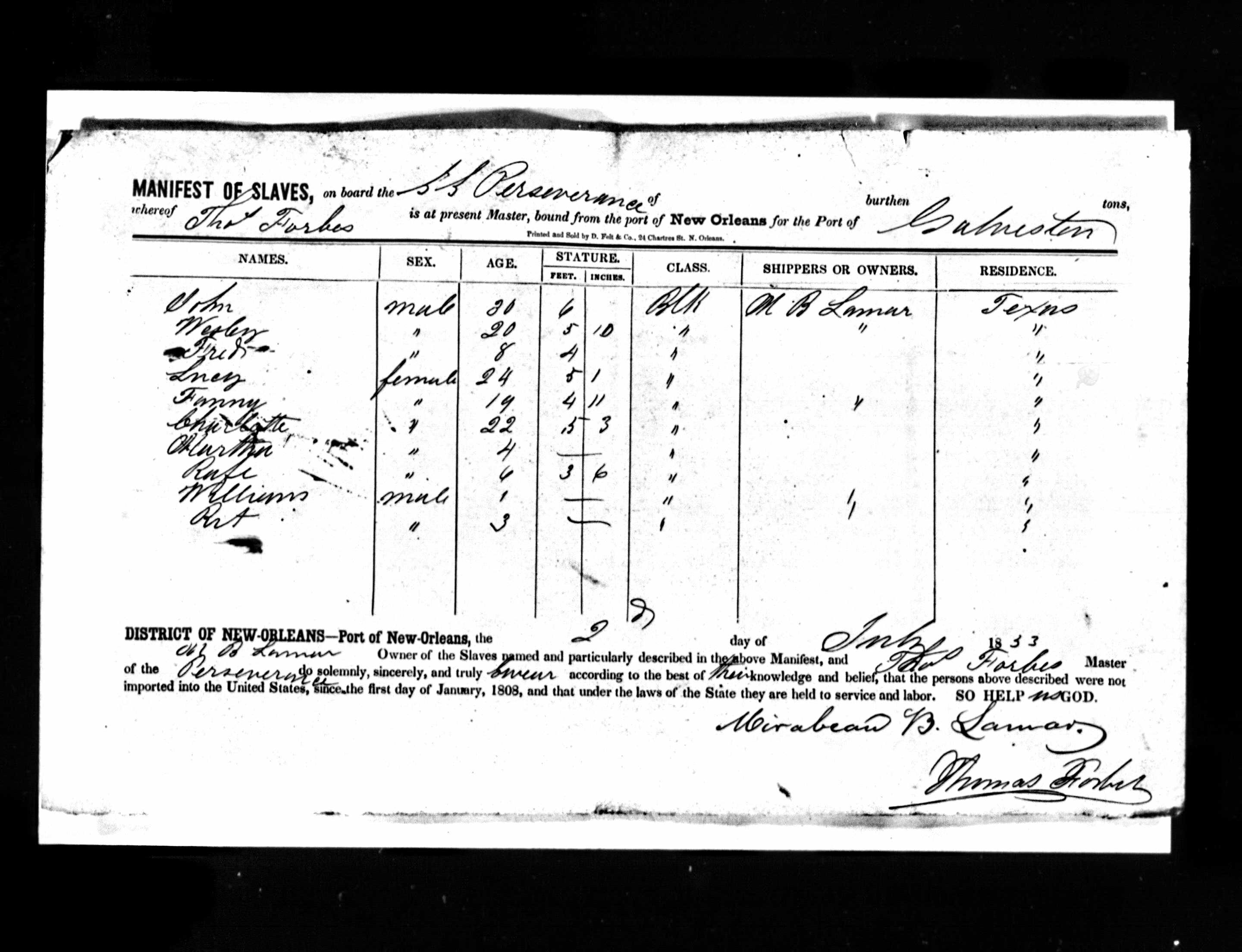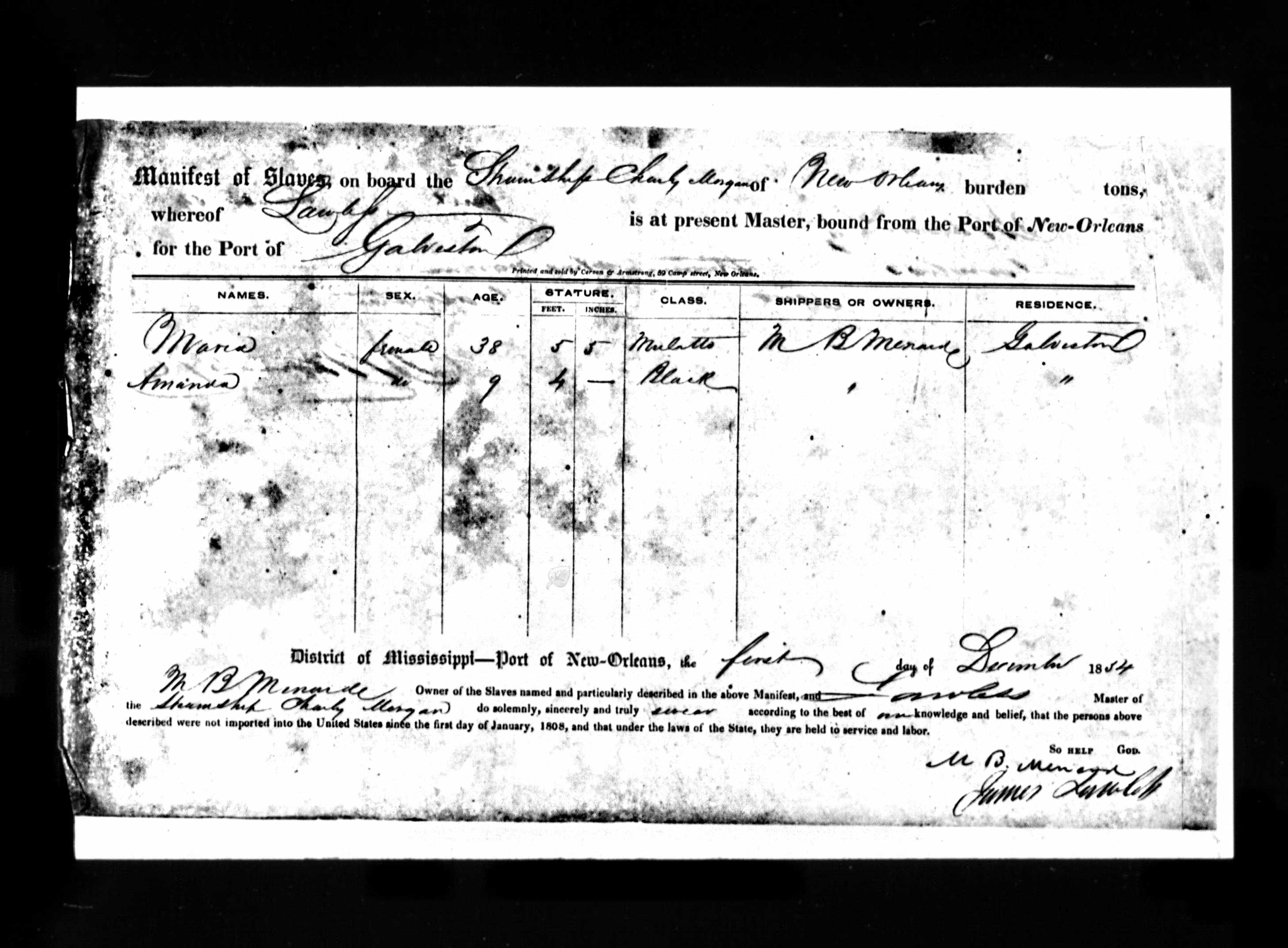The names and faces of Anglo Texas’ founding fathers and Confederate sons loom large in Texans’ collective memory and public spaces, from the Texas Heroes Monument in Galveston to the Confederate Soldiers’ Monument on the lawn of the State Capitol in Austin. Rice University researchers, including myself, began encountering some of these names in slave manifests documenting the forced movement of enslaved people into the Texas Gulf Coast.
These records, now accessible on the SlaveVoyages website, give public historians and educators the primary documents necessary to expand upon curriculums for teaching about colonial Texas in which Anglo Texans are often aggrandized and slavery is overlooked. In light of measures taken by Texas lawmakers to promote a sanitized version of Texas history and limit conversations about race and racism in the classroom, tools like SlaveVoyages are even more significant. The names of enslavers and shippers responsible for carrying out these voyages, now searchable through the Enslavers Database, can help challenge and augment our understanding of historical figures whose involvement in the institution of slavery has long been omitted from Texas history.

Figure 1 – National Archives and Records Administration (Washington, DC) - Slave Manifests of Coastwise Vessels Filed at New Orleans, Louisiana, 1807-1860, Outward Series, v. Microfilm Serial M1895, RG 36. SlaveVoyages.org Voyage ID 136064.
For example, we discovered that Mirabeau Lamar, the second president of the Republic of Texas, filled out two manifests for the transportation of eleven enslaved people on two separate voyages from New Orleans to Galveston. On July 2, 1833, Lamar arranged the voyage of John, Wesley, Fred, Lucy, Fanny, Charlotte, Martha, Rafe, William, and Ret from New Orleans to Galveston. Ten years later, on January 7, 1843, Lamar arranged the voyage of a 26-year-old man named John from New Orleans to Galveston. While Lamar was already identifiable as an enslaver in the U.S. Slave Schedules of 1850 and 1860, these manifests name some of those whom he enslaved and show how they had been brought to Texas.
Like most “heroes” of the Texas Revolution and the Republic era, Lamar is widely revered and remains a namesake of a county and many schools and streets throughout the state. Meanwhile, his complicity in and advocacy for slavery in Texas are excused or ignored.

Figure 2 – National Archives and Records Administration (Washington, DC) - Slave Manifests of Coastwise Vessels Filed at New Orleans, Louisiana, 1807-1860, Outward Series, v. Microfilm Serial M1895, RG 36. SlaveVoyages.org Voyage ID: 135679.
Another prominent Texan figure identified as an enslaver in the manifests is Michel Branamour Menard, one of the principal founders of Galveston. On April 2, 1853, Menard signed a manifest indicating the transportation of Maria, a 35-year-old woman, from Galveston to New Orleans. On April 20, 1853, Menard signed another manifest documenting Maria’s return to Galveston. On December 2, 1854, Maria and a 9-year old-girl named Amanda, also enslaved by Menard, were documented on a voyage from New Orleans to Galveston. It’s unclear whether Maria listed in 1854, who is described as 38-years-old, was the same woman as the 35-year-old Maria documented in 1853.
Menard is often celebrated as a patriarch of the city, and his 1838 mansion, which still stands on the island, is host to tourism and celebrations which do little to recognize those who lived in bondage there.
Our work continues not only in expanding research on the coastwise traffic to Texas, but in sharing these discoveries with public historians and educators so they can potentially enhance their interpretations of slavery and disrupt romantic celebrations of enslavers. While these men made important contributions to the development of Texas, which surely have a place in history education, they did so with wealth, social influence, and power derived from the institution of slavery.
We began sharing these insights with the public in December 2021 with a presentation at the Bound Away conference at Rice University. In February 2022, we shared our research with the Houston chapter of the Afro-American Historical and Genealogical Society via an online conference. We emphasized the potential of SlaveVoyages, particularly the Oceans of Kinfolk database, as a tool for genealogical research into the lifeways of enslaved ancestors. I still remember a comment from an attendee who appreciated our interrogation of romantic glorifications.
Over the past year, we have presented our research to museums and historic sites throughout southeast Texas. In this region especially, defined by the Texas Historical Commission (THC) as the Texas Independence Trail Region, “larger-than-life images of explorers, heroes, and settlers such as René Robert Cavelier, Sieur de La Salle, Stephen F. Austin, Sam Houston and Davy Crockett resonate.” It is one of our priorities to share our data, interpretations, and remaining questions with public history institutions that serve Texas communities where the history and legacy of slavery still suffuses their present-day landscapes.
In February 2023, we presented our findings at the Freeport Historical Museum, in Freeport, TX, in conjunction with a temporary exhibit “‘This Worst of Evils’: Slavery in Brazoria County.” Formerly known as Velasco, Freeport and the Brazos River that runs through the city into the Gulf, are directly implicated in the SlaveVoyages Texas data as ports of entry for enslaved people.
Our research will inform new interpretive panels at the Jackson Plantation Historic Site, a State Antiquities Landmark with extant archaeological remains of a 19th century sugar and cotton plantation established by Abner Jackson. Managed today by the Lake Jackson Historical Association, the site has vast opportunities to educate the public about slavery in southern Brazoria County, including the coastwise slave trade. Similarly, THC staff at Levi Jordan and Varner-Hogg Plantation State Historic Sites are interested in expanding historical narratives of slavery there to include the coastwise trade. Whether any of the men, women, and children who we identified in our research eventually came to live or work at these particular plantations remains to be seen. Still, the enslaved population of southern Brazoria County very likely would have known about the coastwise trade as people arrived at nearby ports and river docks.
In cities like Lake Jackson or historic sites like Levi Jordan which still carry the name of their founding enslavers and are responsible with preserving their history, it is vital that their roles in producing and perpetuating a slaveholders’ republic was not unique, but rather just one instance of systematic and normalized brutality that was once viewed as the cornerstone of ideal Texan society, espoused by the state’s most popular “heroes.”
We developed a poster exhibit, titled “Finding Texas on the SlaveVoyages Database,” sponsored by and initially displayed in Fondren Library at Rice from April through August 2022. With Rice University’s reckoning with its own founder’s participation in the institution of slavery, the display was deeply relevant and challenging to the time and space in which Rice students and Houstonians encountered it. The exhibit is now on display at the Juneteenth Legacy Project Headquarters, located in Galveston’s famous downtown strip known as The Strand. We hope that our exposure of men like Lamar and Menard disrupts public tourism spaces such as the Strand that have routinely undermined their local histories of slavery and aggrandized enslavers.
In order to tell the whole truth of how Texas came to be, it is critical that we recognize and discuss the ways in which white men who are memorialized in popular history and public spaces — for their wealth, entrepreneurship, political or military contributions, etc. — built their monuments on the backs of enslaved Black men, women, and children. The new data on the Texas traffic now available on SlaveVoyages have opened vast opportunities to do so.
Katelyn is a recent history graduate from Rice University. She is currently the Program & Education Coordinator at the Lake Jackson Historical Association.
The post “Changing Public History” first appeared in Echoes: The SlaveVoyages Blog. It is part of a series of posts exploring the history and legacies of the slave trade to Texas.
